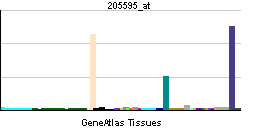Desmoglein 3
| Desmoglein 3 (pemphigus vulgaris antigen) | |||||||||||
|---|---|---|---|---|---|---|---|---|---|---|---|
| Identifiers | |||||||||||
| Symbols | DSG3 ; CDHF6; DKFZp686P23184; PVA | ||||||||||
| External IDs | Template:OMIM5 Template:MGI HomoloGene: 55513 | ||||||||||
| |||||||||||
| RNA expression pattern | |||||||||||
 | |||||||||||
| More reference expression data | |||||||||||
| Orthologs | |||||||||||
| Template:GNF Ortholog box | |||||||||||
| Species | Human | Mouse | |||||||||
| Entrez | n/a | n/a | |||||||||
| Ensembl | n/a | n/a | |||||||||
| UniProt | n/a | n/a | |||||||||
| RefSeq (mRNA) | n/a | n/a | |||||||||
| RefSeq (protein) | n/a | n/a | |||||||||
| Location (UCSC) | n/a | n/a | |||||||||
| PubMed search | n/a | n/a | |||||||||
Desmoglein 3 (pemphigus vulgaris antigen), also known as DSG3, is a human gene.[1]
Desmosomes are cell-cell junctions between epithelial, myocardial, and certain other cell types. Desmoglein 3 is a calcium-binding transmembrane glycoprotein component of desmosomes in vertebrate epithelial cells. Currently, three desmoglein subfamily members have been identified and all are members of the cadherin cell adhesion molecule superfamily. These desmoglein gene family members are located in a cluster on chromosome 18. This protein has been identified as the autoantigen of the autoimmune skin blistering disease pemphigus vulgaris.[1]
See also
References
Further reading
- Arnemann J, Spurr NK, Buxton RS (1992). "The human gene (DSG3) coding for the pemphigus vulgaris antigen is, like the genes coding for the other two known desmogleins, assigned to chromosome 18". Hum. Genet. 89 (3): 347–50. PMID 1601426.
- Amagai M, Klaus-Kovtun V, Stanley JR (1992). "Autoantibodies against a novel epithelial cadherin in pemphigus vulgaris, a disease of cell adhesion". Cell. 67 (5): 869–77. PMID 1720352.
- Roh JY, Stanley JR (1995). "Plakoglobin binding by human Dsg3 (pemphigus vulgaris antigen) in keratinocytes requires the cadherin-like intracytoplasmic segment". J. Invest. Dermatol. 104 (5): 720–4. PMID 7738346.
- Wang Y, Amagai M, Minoshima S; et al. (1994). "The human genes for desmogleins (DSG1 and DSG3) are located in a small region on chromosome 18q12". Genomics. 20 (3): 492–5. doi:10.1006/geno.1994.1207. PMID 8034325.
- Schäfer S, Koch PJ, Franke WW (1994). "Identification of the ubiquitous human desmoglein, Dsg2, and the expression catalogue of the desmoglein subfamily of desmosomal cadherins". Exp. Cell Res. 211 (2): 391–9. doi:10.1006/excr.1994.1103. PMID 8143788.
- Kárpáti S, Amagai M, Prussick R; et al. (1993). "Pemphigus vulgaris antigen, a desmoglein type of cadherin, is localized within keratinocyte desmosomes". J. Cell Biol. 122 (2): 409–15. PMID 8320263.
- Silos SA, Tamai K, Li K; et al. (1996). "Cloning of the gene for human pemphigus vulgaris antigen (desmoglein 3), a desmosomal cadherin. Characterization of the promoter region and identification of a keratinocyte-specific cis-element". J. Biol. Chem. 271 (29): 17504–11. PMID 8663392.
- Marsden MD, Collins JE, Greenwood MD; et al. (1997). "Cloning and transcriptional analysis of the promoter of the human type 2 desmocollin gene (DSC2)". Gene. 186 (2): 237–47. PMID 9074502.
- Adams MJ, Reichel MB, King IA; et al. (1998). "Characterization of the regulatory regions in the human desmoglein genes encoding the pemphigus foliaceous and pemphigus vulgaris antigens". Biochem. J. 329 ( Pt 1): 165–74. PMID 9405290.
- Shirakata Y, Amagai M, Hanakawa Y; et al. (1998). "Lack of mucosal involvement in pemphigus foliaceus may be due to low expression of desmoglein 1". J. Invest. Dermatol. 110 (1): 76–8. doi:10.1046/j.1523-1747.1998.00085.x. PMID 9424092.
- Amagai M, Nishikawa T, Nousari HC; et al. (1998). "Antibodies against desmoglein 3 (pemphigus vulgaris antigen) are present in sera from patients with paraneoplastic pemphigus and cause acantholysis in vivo in neonatal mice". J. Clin. Invest. 102 (4): 775–82. PMID 9710446.
- Ishikawa H, Li K, Tamai K; et al. (2001). "Cloning of the mouse desmoglein 3 gene (Dsg3): interspecies conservation within the cadherin superfamily". Exp. Dermatol. 9 (4): 229–39. PMID 10949543.
- Czerwenka KF, Manavi M, Hosmann J; et al. (2001). "Comparative analysis of two-dimensional protein patterns in malignant and normal human breast tissue". Cancer Detect. Prev. 25 (3): 268–79. PMID 11425269.
- Weiske J, Schöneberg T, Schröder W; et al. (2001). "The fate of desmosomal proteins in apoptotic cells". J. Biol. Chem. 276 (44): 41175–81. doi:10.1074/jbc.M105769200. PMID 11500511.
- Andl CD, Stanley JR (2001). "Central role of the plakoglobin-binding domain for desmoglein 3 incorporation into desmosomes". J. Invest. Dermatol. 117 (5): 1068–74. doi:10.1046/j.0022-202x.2001.01528.x. PMID 11710914.
- Merritt AJ, Berika MY, Zhai W; et al. (2002). "Suprabasal desmoglein 3 expression in the epidermis of transgenic mice results in hyperproliferation and abnormal differentiation". Mol. Cell. Biol. 22 (16): 5846–58. PMID 12138195.
- Strausberg RL, Feingold EA, Grouse LH; et al. (2003). "Generation and initial analysis of more than 15,000 full-length human and mouse cDNA sequences". Proc. Natl. Acad. Sci. U.S.A. 99 (26): 16899–903. doi:10.1073/pnas.242603899. PMID 12477932.
- Hanakawa Y, Amagai M, Shirakata Y; et al. (2003). "Differential effects of desmoglein 1 and desmoglein 3 on desmosome formation". J. Invest. Dermatol. 119 (6): 1231–6. doi:10.1046/j.1523-1747.2002.19648.x. PMID 12485422.
- Veldman C, Stauber A, Wassmuth R; et al. (2003). "Dichotomy of autoreactive Th1 and Th2 cell responses to desmoglein 3 in patients with pemphigus vulgaris (PV) and healthy carriers of PV-associated HLA class II alleles". J. Immunol. 170 (1): 635–42. PMID 12496453.
- Posthaus H, Dubois CM, Müller E (2003). "Novel insights into cadherin processing by subtilisin-like convertases". FEBS Lett. 536 (1–3): 203–8. PMID 12586364.